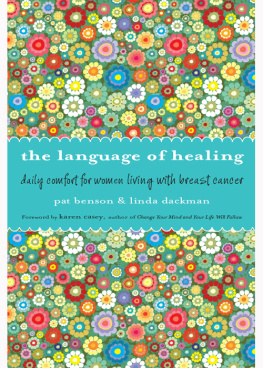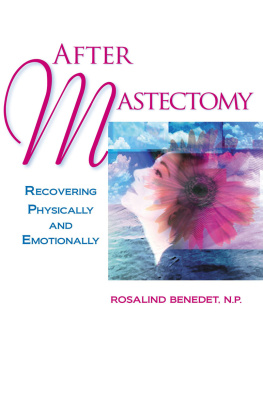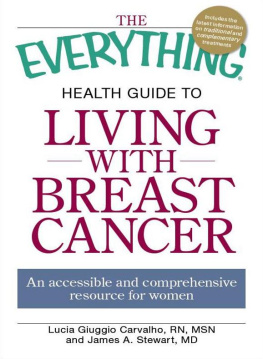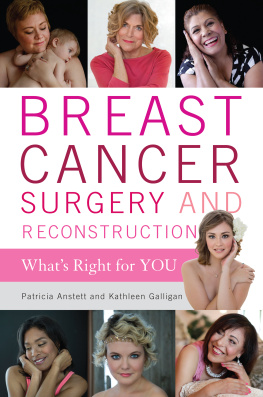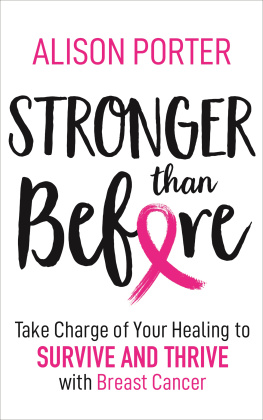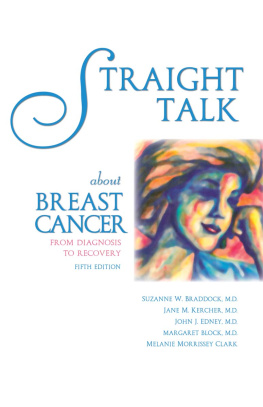THE BREAST RECONSTRUCTION GUIDEBOOK
KATHY STELIGO
THE BREAST RECONSTRUCTION GUIDEBOOK
Issues and Answers
from Research to Recovery
THIRD EDITION

Note to the Reader: This book is not meant to substitute for medical care of people with breast cancer or risk of breast cancer, and treatment should not be based solely on its contents. Instead, treatment must be developed in a dialogue between the individual and his or her physician. This book has been written to help with that dialogue.
All efforts have been made to ensure the accuracy of the information contained in this book as of the date of publication. The author and the publisher expressly disclaim responsibility for any adverse outcomes arising from the use or application of the information contained herein.
The author and publisher have made reasonable efforts to determine that the selection and dosage of drugs and treatments discussed in this text conform to the practices of the general medical community. The medications described do not necessarily have specific approval by the U.S. Food and Drug Administration for the uses for which they are recommended. The reader is urged to check the package insert of each drug for any change in indications and dosage and for warnings and precautions. This is particularly important when the recommended agent is a new and/or infrequently used drug.
2012 The Johns Hopkins University Press
All rights reserved. Published 2012
Previous editions 2005 Kathy Steligo
Printed in the United States of America on acid-free paper
9 8 7 6 5 4 3 2 1
The Johns Hopkins University Press
2715 North Charles Street
Baltimore, Maryland 21218-4363
www.press.jhu.edu
LIBRARY OF CONGRESS
CATALOGING-IN-PUBLICATION DATA
Steligo, Kathy.
The breast reconstruction guidebook : issues and answers from research to recovery / Kathy Steligo. 3rd ed.
p. cm.
Includes bibliographical references and index.
ISBN 978-1-4214-0719-7 (hdbk. : alk. paper)
ISBN 978-1-4214-0720-3 (pbk. : alk. paper)
ISBN 978-1-4214-0783-8 (electronic)
ISBN 1-4214-0719-1 (hdbk. : alk. paper)
ISBN 1-4214-0720-5 (pbk. : alk. paper)
ISBN 1-4214-0783-3 (electronic)
1. MammaplastyPopular works. 2. Musculocutaneous flapsPopular works. 3. MammaplastyComplicationsPopular works. 4. WomenHealth and hygienePopular works. 5. BreastCancerSurgeryPopular works. 6. BreastCancerPatientsRehabilitationPopular works. I. Title.
RD539.8.S73 2013
618.190592dc23 2012008908
A catalog record for this book is available from the British Library.
Special discounts are available for bulk purchases of this book. For more information, please contact Special Sales at 410-516-6936 or specialsales@press.jhu.edu.
The Johns Hopkins University Press uses environmentally friendly book materials, including recycled text paper that is composed of at least 30 percent post-consumer waste, whenever possible.
Contents
Foreword
Debbie Horwitz
Breast Cancer Survivor
Project Creator, Myself: Together Again
I am no stranger to breast cancer. I am a seven-year survivor at age 39, my moms exact age when she died of this disease. When I was diagnosed, my breast surgeon recommended lumpectomy, saying that getting rid of the tumor in my right breast would cure my cancer as effectively as a mastectomy. But if I chose that option, and also chose to keep my healthy breast, it was what he couldnt remove or cure that would worry me and cause anxiety for the rest of my life. My surgeon wanted me to consider all of the losses from mastectomy. He was concerned that intimacy would be a problem for me after a double mastectomy and that breastfeeding would not be an option. I did consider all of his pointsthe pros, the cons, and everything in betweenwhen I was making my treatment decisions, but I kept coming back to the idea of doing whatever it would take to never again be diagnosed with this disease. I cant help but wonder: What if I wasnt such a strong advocate for myself at the time of diagnosis? If I had never questioned my surgeons advice, would I be okay with how things turned out? Would I still be a survivor today?
Deciding to have a double mastectomy is not something I have any regrets about. Taking this more aggressive route may not be right for everyone, but in my heart and my mind, this was my only alternative. I have to be honest and say that I miss the body I used to have. Getting comfortable with my new body was far from an overnight process. Even after the saline implants and nipple tattooing were completed, there were moments when I longed for my old self. The scars never really go away. They fade, but when you look closely at yourself, they are still a reminder that cancer was once there. But Im still pleased with my reconstruction results and feel thankful that I look close to normal. Ive grown into the body that I have now, and no matter how difficult the process was in getting here, it was worth it to feel complete. Reconstruction was the right choice for me. It is not what everyone chooses, and I understand why that is, but for me there are no regrets. Today, in terms of symmetry and my overall look, I know I made a good choice. More important, in terms of my mental health, I think I am in a good place in my life now because I trusted my gut feelings and didnt allow the research to override my instincts.
In this book, Kathy Steligo provides all the information you need to know about reconstruction, including the emotional aspects and the time it takes to adjust to your new breasts and your new self. This is not talked about in much of the literaturethe idea that breast reconstruction really is life-changing in so many ways. As a young survivor, I will tell you that I am so fortunate not to have suffered the same fate as my mother. The things I had to give up in my life as a result of losing my breasts were true losses, but they hold no comparison to my feelings of being alive and living a full life.
Kathy, I know I speak for so many women when I say thank you for your accurate description of reconstruction in the pages of this easy-to-read book, and for continuing the conversation about reconstruction that begins in the surgeons officethe conversation that seems too overwhelming to hear in just one appointment. You are honest, you answer our questions, you ease our fears, and you get us prepared. I have learned that the rest is up to us: listening to our own feelings and trusting ourselves, advocating for what feels right, grieving, accepting our choices, and moving forward and embracing our new self. For me, its been a continuing process over the seven years since my surgery. I am still sorting it all out, but each day has brought more understanding, more healing, and more happiness.
For all of you taking on breast reconstruction, after you finish the last page of this book, do yourself a favor and keep the topic open. Because reconstruction truly is life-changing, and we are not expected to get it all after we close a book. Let this book be your guide, then allow your mind to process and your heart to feel, and know that it is possible to feel whole again.
Wishing you good health and happiness.
Acknowledgments
Sincere thanks to all those who shared their experiences and insights about mastectomy and reconstruction.
My gratitude goes to the busy surgeons who took the time to provide their expert opinions and patients photos: Drs. Rudolph Buntic, Frank Della-Croce, Gail Lebovic, Joshua Levine, Michel Saint-Cyr, and C. Andrew Salzberg. Thank you also to Amoena USA Corporation, Lori Bruckheim, Amy Burgess, and Tony Cane-Honeysett for contributing photos.
Next page


